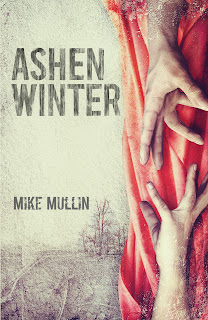One of my pet peeves with post-apocalyptic books is when they get survival details wrong. I won’t name names, but I’ve thrown three books across the room in disgust just in the last year. For my debut novel, ASHFALL, and its sequel, ASHEN WINTER, I worked hard to get the details right. Fortunately, I had a couple of advantages over most authors.
First, as a teenager I loved learning about and practicing outdoor survival. I started fires with a bow and drill set I made myself. I harvested puffballs from our front yard and fried them. I ate fresh pods from our redbud trees, flowers from our black locusts, and made tea from white pine needles and sassafras roots (sassafras contains a carcinogenic chemical, by the way—I love the tea, but drink it only rarely). I even went into the woods once with nothing but a knife and clothing for three days and emerged only a little thinner and a lot dirtier. So when I write about survival topics, I’m usually drawing on personal experience.
Second, in ASHFALL the volcanic ash from the eruption of the Yellowstone supervolcano changes the environment dramatically. Wild animals inhale the ash, get silicosis, and die. Plants are buried in the ash and suffocated. Or they die in the long volcanic winter that I depict in the sequel, ASHEN WINTER. So a lot of traditional survival strategies and foods just aren’t available to my protagonists, Alex and Darla. Which means there are fewer details I could potentially mess up.
Today I prefer restaurants to wild food and hotels to improvised shelter, but I still enjoy the occasional wild meal. In early spring, I can make a lovely salad from my backyard, because I don’t put any chemicals on it and I don’t mind the weeds—many of which are yummy! I got in big trouble with my wife one year when I stripped all the buds from our daylilies to make a delicious green-bean-like dish. Turns out she would have preferred looking at the flowers to eating the buds. Who knew?
Here’s my advice if you want to try eating wild food: get good guidebooks for your area. My three favorites (I live in Indiana) are The Forager’s Harvest, Peterson’s Field Guide to Edible Wild Plants of Eastern/Central North America, and Primitive Living and Survival Skills.
Some more advice: don’t eat mushrooms unless you have a stone-cold expert with you. Morels and puffballs are okay and some kinds of shelf-fungus. With mushrooms, if you make a mistake, you could wind up like this guy. There’s a reason two commonly misidentified mushrooms are called Death Cap and Destroying Angel. Just saying.
Also, it used to be that you could eat almost any rodent or small animal safely, and some guide books still have that advice. No more. BSE, or mad cow disease, has shown up in rats, squirrels, elk and deer. It’s deadly, and there’s no cure. If I were starving and had no other options, I’d eat rats or squirrels, but I’d do my very best not to eat any brain or nerve tissue that might carry the BSE prion.
So, that’s a little advice on edible wild foods. How do Alex and Darla manage to survive when almost all the wild food has been destroyed by the ashfall and volcanic winter? Read ASHFALL and ASHEN WINTER to find out!
Bio
Mike Mullin’s first job was scraping the gum off the undersides of desks at his high school. From there, things went steadily downhill. He almost got fired by the owner of a bookstore due to his poor taste in earrings. He worked at a place that showed slides of poopy diapers during lunch (it did cut down on the cafeteria budget). The hazing process at the next company included eating live termites raised by the resident entomologist, so that didn’t last long either. For a while Mike juggled bottles at a wine shop, sometimes to disastrous effect. Oh, and then there was the job where swarms of wasps occasionally tried to chase him off ladders. So he’s really glad this writing thing seems to be working out.
Mike holds a black belt in Songahm Taekwondo. He lives in Indianapolis with his wife and her three cats. Ashen Winter is his second novel. His debut, Ashfall, was named one of the top five young adult novels of 2011 by National Public Radio, a Best Teen Book of 2011 by Kirkus Reviews, and a New Voices selection by the American Booksellers Association.
About ASHEN WINTER
It's been over six months since the eruption of the Yellowstone supervolcano. Alex and Darla have been staying with Alex's relatives, trying to cope with the new reality of the primitive world so vividly portrayed in Ashfall, the first book in this trilogy. It's also been six months of waiting for Alex's parents to return from Iowa. Alex and Darla decide they can wait no longer and must retrace their journey into Iowa to find and bring back Alex's parents to the tenuous safety of Illinois. But the landscape they cross is even more perilous than before, with life-and-death battles for food and power between the remaining communities. When the unthinkable happens, Alex must find new reserves of strength and determination to survive.
Excerpt
The first two chapters are available on my website: www.ashenwinter.com. You may reprint the first two chapters in whole or in part on your website so long as you do not charge anyone anything to access them.




Wow. I am impressed. I look forward to many more Mike Mullins novels where characters survive in creative ways. Can't wait for ASHEN WINTER. Thanks for the two chapters....
ReplyDeleteI love your blog tour, Mike Mullins. You are doing some fascinating posts. Thanks for hosting him, Jody.
ReplyDelete